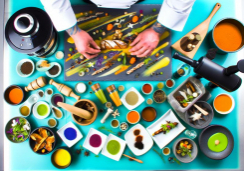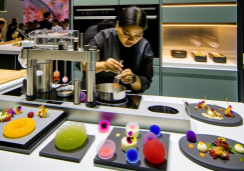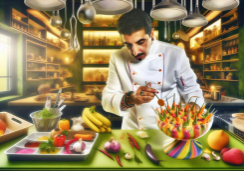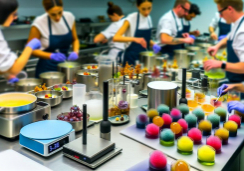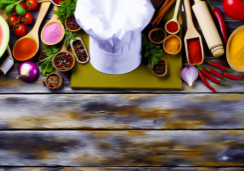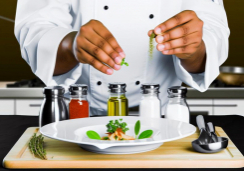Your Guide to Creating Gluten-Free Baking Recipes
Navigating the world of gluten-free baking can often feel like exploring uncharted territory, but you're about to embark on a journey that promises to demystify this culinary landscape.
As you turn the page on traditional wheat-based recipes, you'll discover that creating delectable gluten-free treats isn't just about subtraction—it's an art form in its own right. You'll learn the secrets to replicating the textures and flavors you love, understand the critical role of alternative flours and gums, and master the substitutions that cater not just to gluten sensitivities but to a range of dietary needs.
With these carefully crafted guidelines, you're set to achieve baking excellence. Stay with me, and I'll show you how to transform what may initially seem like limitations into a canvas of endless possibility.
Understanding Gluten-Free Flours
Diving into the world of gluten-free baking, it's essential to grasp how alternative flours—like almond, coconut, and rice flour—behave differently than traditional wheat flour, affecting everything from moisture content to structural integrity in your culinary creations. These gluten-free flours don't just swap out directly; they're a different playing field altogether.
With gluten-free flour, you're working with a mix that often includes potato starch and tapioca starch, which have higher liquid absorption rates. This means you'll need to adjust the amount of liquid in your recipes to avoid a dry, crumbly disaster. Brown rice flour can lend a nutty flavor and is denser, while almond flour adds richness and moisture. Coconut flour, incredibly absorbent, requires a delicate balance to prevent a dense outcome.
Sorghum flour is closer to wheat in texture and taste, but still, it doesn't have the gluten to pull things together. That's where xanthan gum and guar gum come in; they're the binders that give your treats structure without the gluten. They mimic the elasticity and stickiness, ensuring your cookies aren't just tasty but also don't fall apart the moment they leave the safety of the baking sheet.
Essential Baking Substitutions
As you've familiarized yourself with the unique qualities of gluten-free flours, let's explore the essential baking substitutions that will help maintain the deliciousness and structure of your favorite treats. GF baking is a delightful adventure with the right tweaks.
- Swap traditional flour for a finely-milled all-purpose blend to achieve a tender crumb in your cakes and cookies. Measuring by weight ensures precision and consistency.
- Introduce gluten free oats or oat flour for a wholesome, nutty flavor in your morning muffins or hearty bread, inspiring warmth and comfort with every bite.
- Use a dash more baking powder and/or a touch of xanthan gum to give your creations the lift and stability that gluten would usually provide, crafting airy and satisfying textures.
When crafting gluten free baking recipes, remember that flour blends can be as unique as your culinary aspirations. Flourless baking opens a world of creativity, using ground nuts or seeds for a rich, flavorful base. Let your doughs and batters rest to hydrate the flour, a simple step that transforms the outcome from good to sublime.
With these essential baking substitutions, you'll craft delectable treats that echo the love and care in every spoonful.
Perfecting Baking Techniques
Mastering gluten-free baking techniques begins with understanding that each recipe requires a precise balance of ingredients tailored to specific flour blends. You're not just baking without gluten; you're crafting a unique harmony of flavors and textures. To achieve the perfect crust or crumb, it's crucial to nail the right ratio of flours and leavening agents. Unlike traditional wheat flour, gluten-free flours often take longer to absorb moisture. Letting your batter rest before baking can give your gluten-free baked goods a head start, allowing the flours to hydrate fully and flavors to meld.
As you delve into easy gluten-free baking, remember that gluten free recipes aren't a one-size-fits-all affair. The absence of gluten – the protein that gives dough its elasticity and cakes their structure – means you'll often be working to develop the gluten's stand-in. This can include a combination of xanthan gum, eggs, or flaxseed to mimic that all-important binding and rising effect.
Your gluten-free baking adventures will lead to moist cakes, flaky pies, and heavenly yeast bread, with a little practice and patience. Embrace these techniques and you'll soon be creating allergen-free magic, serving up gluten free baked goods that are as delightful as their gluten-containing counterparts.
Storing Your Gluten-Free Creations
To keep your gluten-free baked goods tasting as fresh as the day you made them, it's essential to store them properly in airtight containers. Whether you're gluten intolerant or simply embracing a gluten-free diet, you've put heart and soul into baking without gluten, and your delicious gluten-free creations deserve the best care post-oven.
Here's how you can ensure your treats stay delectable:
- Seal the Freshness: Airtight containers are your best friends, keeping moisture in and staleness out.
- Freeze for Longevity: If you won't devour your goodies right away, freezing extends their life, ensuring you always have a tasty treat on hand.
- Avoid Flavor Ghosts: Store away from strong odors to prevent your gluten-free products from taking on the taste of last night's curry.
Beginner-Friendly Recipe Ideas
Once you've safeguarded your gluten-free baked treasures, it's time to explore some beginner-friendly recipes that promise success even for novice bakers. Start with the basics: Chocolate Chip Cookies. They're a staple in the realm of delicious baked goods and a perfect first foray into gluten-free baking. Replace traditional flour with a gluten-free blend to retain that beloved, chewy texture. Remember, a precise measuring cup is your ally in achieving the right balance in your batters and doughs.
Next on your baking adventure, try Peanut Butter Muffins. They're simple, satisfying, and a delightful twist on a classic. The key to moist, fluffy muffins lies in not overmixing the batter. Just combine the wet and dry ingredients until they're just incorporated. These recipes not only yield scrumptious treats but also build your confidence in handling gluten-free flours.
Your guide to gluten-free baking doesn't end here. Embrace recipes that turn traditional favorites into allergen-free joys. With a bit of creativity and the right techniques, you'll master everything from flaky pies to heavenly yeast bread. Just remember, whether it's your first or fiftieth batch, each gluten-free creation is a step toward becoming a baking maestro.
Conclusion
Now you've got the tools to bake up a storm, gluten-free style! Embrace the array of flours, master the swap-outs, and finesse those techniques.
Store your treats right, and they'll taste just-baked fresh. Whether you're whipping up your first batch of muffins or tackling a fancy pie, you're ready to create magic in the kitchen.
So preheat that oven and let your baking adventure begin—with every bite as delightful as the last!

